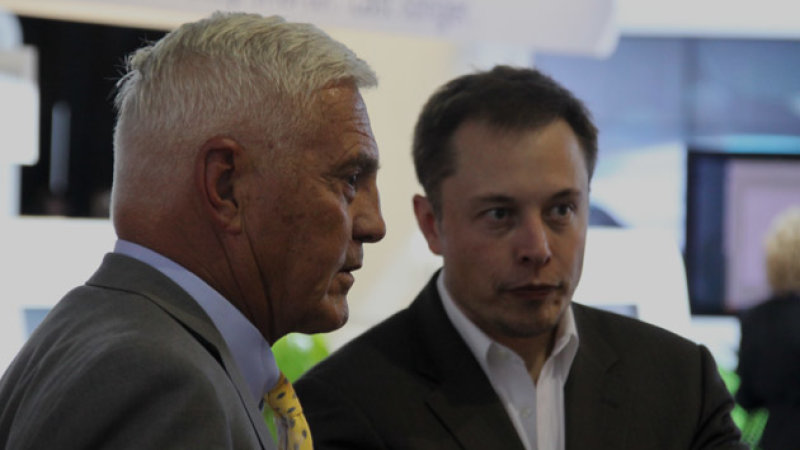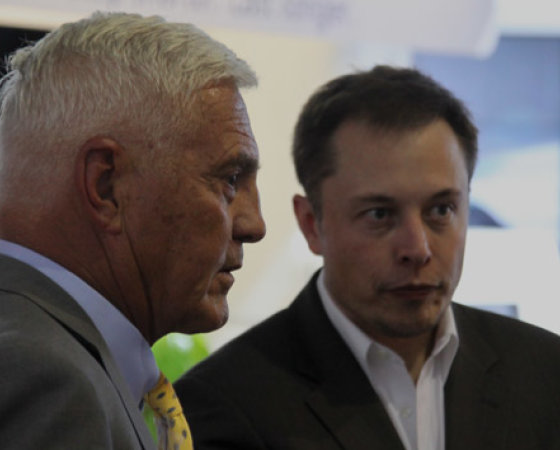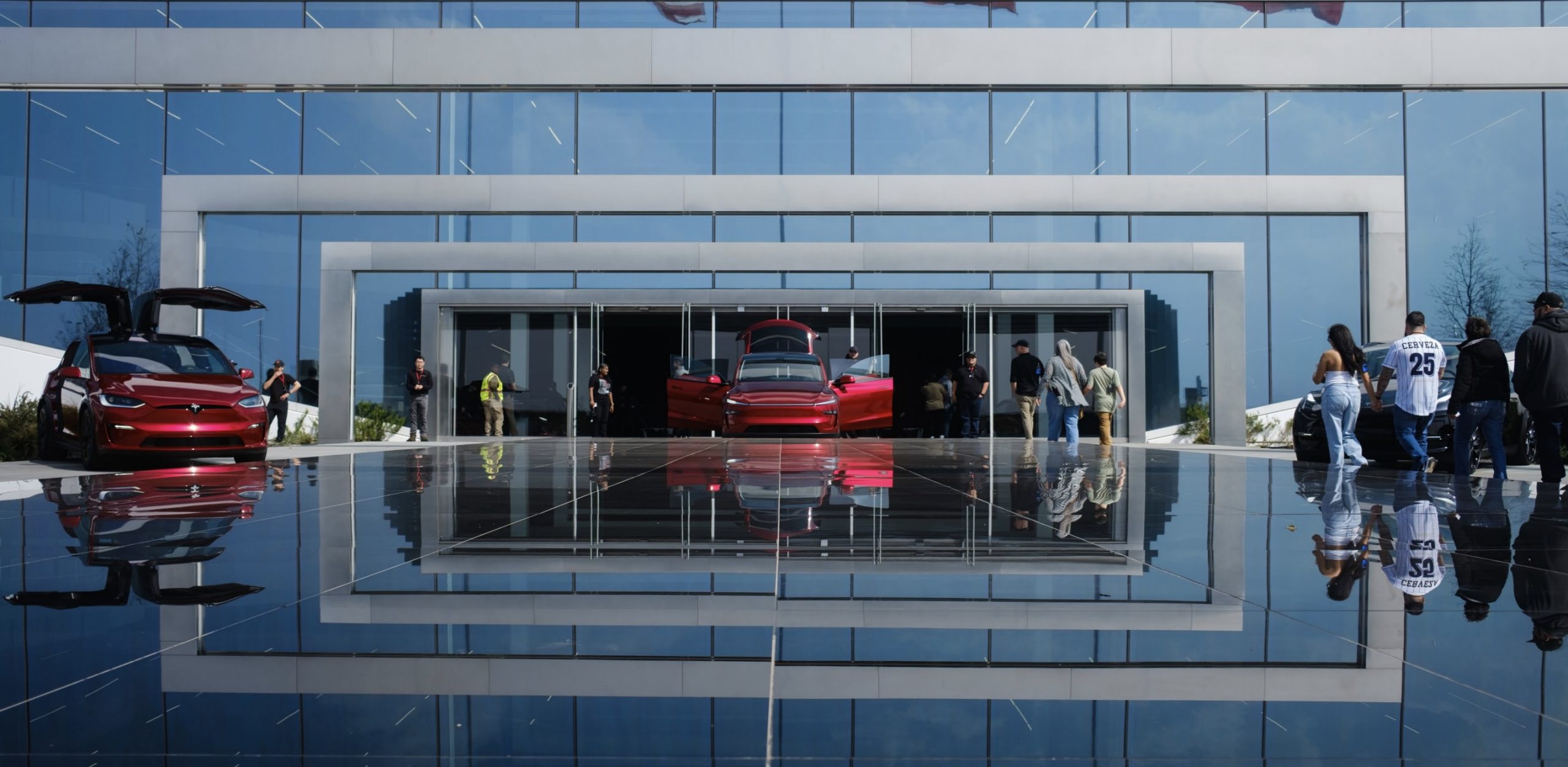

Investor's Corner
Tesla critic Bob Lutz vs. Elon Musk: A look back behind the bluster
In this corner, the father of the Chevrolet Volt, an auto industry veteran who has held senior positions at Chrysler, Ford and BMW, an unlikely advocate for EVs – a cigar-chomping ex-Marine who has called climate change “a crock.” Bob Lutz!
In the other corner, the mastermind of PayPal, SolarCity, and SpaceX, the archetypal Silicon Valley entrepreneur, who wants to electrify transportation and save Planet Earth – and if that doesn’t work, he’ll take us to Mars to start over. Elon Musk!
Back in the day, Bob Lutz was a champion of Tesla and Musk, citing the Roadster as a major inspiration for the Volt, and saying that he would “always owe them a debt of gratitude for having kind of broken the ice.” After Lutz left GM, he founded Via Motors, which set out to build plug-in hybrid vans and pickup trucks for commercial fleets, but has had a difficult time finding its market. The 85-year-old Lutz has written extensively about the auto industry. For whatever reason, he has evolved into a harsh critic of EVs, and especially Tesla. In 2016, he compared Musk to the leader of a religious cult. (Musk responded on Twitter, saying, “Dear cult members, I love you.”)
Dear cult members, I love you https://t.co/1OzRaSQzhT
— Elon Musk (@elonmusk) October 26, 2016
Lutz launched his latest salvo against the California upstarts at a forum sponsored by a provider of insurance for collectible cars, suggesting that collectors buy a Model S now before Tesla goes belly-up. He had nothing but praise for the car itself: “A Model S, especially with the performance upgrades, is one of the fastest, best handling, best braking sedans that you could buy in the world today,” he said. “The acceleration times will beat any $350,000 European exotic.”
However, Lutz said Elon Musk “hasn’t figured out the revenues have to be greater than costs…when you are perennially running out of cash you are just not running a good automobile company. I don’t see anything on the horizon that’s going to fix that, so those of you who are interested in collector cars, may I suggest buying a Tesla Model S while they’re still available.”
Above: Bob Lutz starts to discuss Tesla and Elon Musk at the 1:06:19 mark in the video (Youtube: Hagerty via InsideEVs)
“Twenty-five years from now, [the Model S] will be remembered as the first really good-looking, fast electric car,” Lutz told the LA Times. “People will say ‘Too bad they went broke.’”
This time, Musk does not appear to have responded publicly to Lutz’s zinger, but naturally, a number of his disciples have come to his defense. Enrique Dans, writing in Forbes, notes his admiration for Lutz’s writings on the auto industry, but believes that “he has missed something enormously important. In fact, possibly the most important difference between the old and the new economy: fundamentally, timeframes.”
Lutz (along with legions of stock-market analysts) sees Tesla’s ongoing losses as a sign of the company’s inevitable failure. However, according to Dans, “Seeing the bottom line as the be-all and end-all of management is problematic…The principle that revenue must exceed costs is Management 101. The tricky bit is how you define the timeframe in which that has to happen.”
As anyone following the Tesla story knows by now, the company’s stock market valuation has no apparent connection to the number of vehicles it’s producing. Tesla’s market cap, currently around $59 billion, exceeds that of Ford, and rivals those of GM and Honda (which, interestingly, was once the subject of the same sort of criticism now leveled at Tesla). Stock-market pundits tend to see this lofty valuation as madness, proof of the irrationality of Elon Musk’s mindless minions. However, Enrique Dans finds the reason in fundamental differences in the companies’ missions, and the timeframes in which they expect to fulfill them.
If you parse the pedantic “mission statements” on the legacy automakers’ web sites, you’ll find that they basically amount to: “We want to sell cars.” Tesla’s mission statement is very different: “To accelerate the advent of sustainable transport by bringing compelling mass market electric cars to market as soon as possible.”
Tesla doesn’t just want to sell cars, it wants to change the world. This massive difference of ambition is reflected in the longer timeframe that Tesla envisions.
“In the economy Bob Lutz and other traditional car industry players understand, the goal and the metrics were clear: the quarterly results,” Dans writes. “If they were below what the analysts expected, bad; if they were higher, good. End of story. But the rules have changed…For today’s companies, profits are not the goal, they’re the cherry on the cake. Because the idea is, in the long term, to move toward an infinitely more ambitious goal, one that entails a whole new level of change. Companies that have grasped this can spend many years, even decades, without making a profit, as long as they are able to create a narrative that shows they are on the right track toward the defined goal.”
Tesla’s long road to ultimate triumph is not unprecedented – it’s a path that’s been trodden by other tech companies that set out to transform an industry. “For how many years did Amazon continue turning in negative quarterly results while its share price rose steadily?” asks Dans. “Did Jeff Bezos…supply his investors with drugs to maintain their confidence? Yes, he did, actually: a powerful substance called growth and clarity in the use of funds obtained. Amazon’s mission was never to sell stuff, but to change the world.”
Amazon is not the only example. In this age of instant communication, in which whole industries can be radically transformed, or even disappear, “reporting a profit each quarter has never been less important.”
“If Lutz is right, if the grand plans for a new economy that will change the world are bullshit, Tesla will go bust,” Dans concedes. “But if Tesla’s plans and strategy make sense, it may well spend a long time in the red, but it will end up as the auto industry’s benchmark.”
Change is taking place ever faster, and humans’ attention spans are growing ever shorter, so it may seem counter-intuitive that the timeline for corporate success should grow longer. However, even in the fast-paced internet era, changing the world, or even one industry, can’t be done in the space of one quarter. Tesla’s mission is a risky one, but so far investors are willing to accept that risk.
Bob Lutz and Elon Musk look at the world in two different ways, and they have very different visions of the future. Which one will prove prophetic? We shall see.
===
Note: Article originally published on evannex.com, by Charles Morris
Source: Forbes

Investor's Corner
Tesla Q4 delivery numbers are better than they initially look: analyst
The Deepwater Asset Management Managing Partner shared his thoughts in a post on his website.

Longtime Tesla analyst and Deepwater Asset Management Managing Partner Gene Munster has shared his insights on Tesla’s Q4 2025 deliveries. As per the analyst, Tesla’s numbers are actually better than they first appear.
Munster shared his thoughts in a post on his website.
Normalized December Deliveries
Munster noted that Tesla delivered 418k vehicles in the fourth quarter of 2025, slightly below Street expectations of 420k but above the whisper number of 415k. Tesla’s reported 16% year-over-year decline, compared to +7% in September, is largely distorted by the timing of the tax credit expiration, which pulled forward demand.
“Taking a step back, we believe September deliveries pulled forward approximately 55k units that would have otherwise occurred in December or March. For simplicity, we assume the entire pull-forward impacted the December quarter. Under this assumption, September growth would have been down ~5% absent the 55k pull-forward, a Deepwater estimate tied to the credit’s expiration.
“For December deliveries to have declined ~5% year over year would imply total deliveries of roughly 470k. Subtracting the 55k units pulled into September results in an implied December delivery figure of approximately 415k. The reported 418k suggests that, when normalizing for the tax credit timing, quarter-over-quarter growth has been consistently down ~5%. Importantly, this ~5% decline represents an improvement from the ~13% declines seen in both the March and June 2025 quarters.“
Tesla’s United States market share
Munster also estimated that Q4 as a whole might very well show a notable improvement in Tesla’s market share in the United States.
“Over the past couple of years, based on data from Cox Automotive, Tesla has been losing U.S. EV market share, declining to just under 50%. Based on data for October and November, Cox estimates that total U.S. EV sales were down approximately 35%, compared to Tesla’s just reported down 16% for the full quarter. For the first two months of the quarter, Cox reported Tesla market share of roughly a 65% share, up from under 50% in the September quarter.
“While this data excludes December, the quarter as a whole is likely to show a material improvement in Tesla’s U.S. EV market share.“
Elon Musk
Tesla analyst breaks down delivery report: ‘A step in the right direction’
“This will be viewed as better than feared deliveries and a step in the right direction for the Tesla story heading into 2026,” Ives wrote.

Tesla analyst Dan Ives of Wedbush released a new note on Friday morning just after the company released production and delivery figures for Q4 and the full year of 2025, stating that the numbers, while slightly underwhelming, are “better than feared” and as “a step in the right direction.”
Tesla reported production of 434,358 and deliveries of 418,227 for the fourth quarter, while 1,654,667 vehicles were produced and 1,636,129 cars were delivered for the full year.
Tesla releases Q4 and FY 2025 vehicle delivery and production report
Interestingly, the company posted its own consensus figures that were compiled from various firms on its website a few days ago, where expectations were set at 1,640,752 cars for the year. Tesla fell about 4,000 units short of that. One of the areas where Tesla excelled was energy deployments, which totaled 46.7 GWh for the year.
🚨 Wedbush’s Dan Ives has released a new note on Tesla $TSLA:
“Tesla announced its FY4Q25 delivery numbers this morning coming in at 418.2k vehicles slightly below the company’s consensus delivery estimate of 422.9k but much better than the whisper numbers of ~410k as the…
— TESLARATI (@Teslarati) January 2, 2026
In terms of vehicle deliveries, Ives writes that Tesla certainly has some things to work through if it wants to return to growth in that aspect, especially with the loss of the $7,500 tax credit in the U.S. and “continuous headwinds” for the company in Europe.
However, Ives also believes that, given the delivery numbers, which were on par with expectations, Tesla is positioned well for a strong 2026, especially with its AI focus, Robotaxi and Cybercab development, and energy:
“This will be viewed as better than feared deliveries and a step in the right direction for the Tesla story heading into 2026. We look forward to hearing more at the company’s 4Q25 call on January 28th. AI Valuation – The Focus Throughout 2026. We believe Tesla could reach a $2 trillion market cap over the coming year and, in a bull case scenario, $3 trillion by the end of 2026…as full-scale volume production begins with the autonomous and robotics roadmap…The company has started to test the all-important Cybercab in Austin over the past few weeks, which is an incremental step towards launching in 2026 with important volume production of Cybercabs starting in April/May, which remains the golden goose in unlocking TSLA’s AI valuation.”
It’s no secret that for the past several years, Tesla’s vehicle delivery numbers have been the main focus of investors and analysts have looked at them as an indicator of company health to a certain extent. The problem with that narrative in 2025 and 2026 is that Tesla is now focusing more on the deployment of Full Self-Driving, its Optimus project, AI development, and Cybercab.
While vehicle deliveries still hold importance, it is more crucial to note that Tesla’s overall environment as a business relies on much more than just how many cars are purchased. That metric, to a certain extent, is fading in importance in the grand scheme of things, but it will never totally disappear.
Ives and Wedbush maintained their $600 price target and an ‘Outperform’ rating on the stock.
Investor's Corner
Tesla releases Q4 and FY 2025 vehicle delivery and production report
Deliveries stood at 406,585 Model 3/Y and 11,642 other models, for a total of 418,227 vehicles.

Tesla (NASDAQ:TSLA) has reported its Q4 2025 production and deliveries, with 418,227 vehicles delivered and 434,358 produced worldwide. Energy storage deployments hit a quarterly record at 14.2 GWh.
Tesla’s Q4 and FY 2025 results were posted on Friday, January 2, 2026.
Q4 2025 production and deliveries
In Q4 2025, Tesla produced 422,652 Model 3/Y units and 11,706 other models, which are comprised of the Model S, Model X, and the Cybertruck, for a total of 434,358 vehicles. Deliveries stood at 406,585 Model 3/Y and 11,642 other models, for a total of 418,227 vehicles.
Energy deployments reached 14.2 GWh, a new record. Similar to other reports, Tesla posted a company thanked customers, employees, suppliers, shareholders, and supporters for its fourth quarter results.
In comparison, analysts included in Tesla’s company-compiled consensus estimate that Tesla would deliver 422,850 vehicles and deploy 13.4 GWh of battery storage systems in Q4 2025.
Tesla’s Full Year 2025 results
For the full year, Tesla produced a total of 1,654,667 vehicles, comprised of 1,600,767 Model Y/3 and 53,900 other models. Tesla also delivered 1,636,129 vehicles in FY 2025, comprised of 1,585,279 Model Y/3 and 50,850 other models. Energy deployments totaled 46.7 GWh over the year.
In comparison, analysts included in Tesla’s company-compiled consensus expected the company to deliver a total of 1,640,752 vehicles for full year 2025. Analysts also expected Tesla’s energy division to deploy a total of 45.9 GWh during the year.
Tesla will post its financial results for the fourth quarter of 2025 after market close on Wednesday, January 28, 2026. The company’s Q4 and FY 2025 earnings call is expected to be held on the same day at 4:30 p.m. Central Time.








